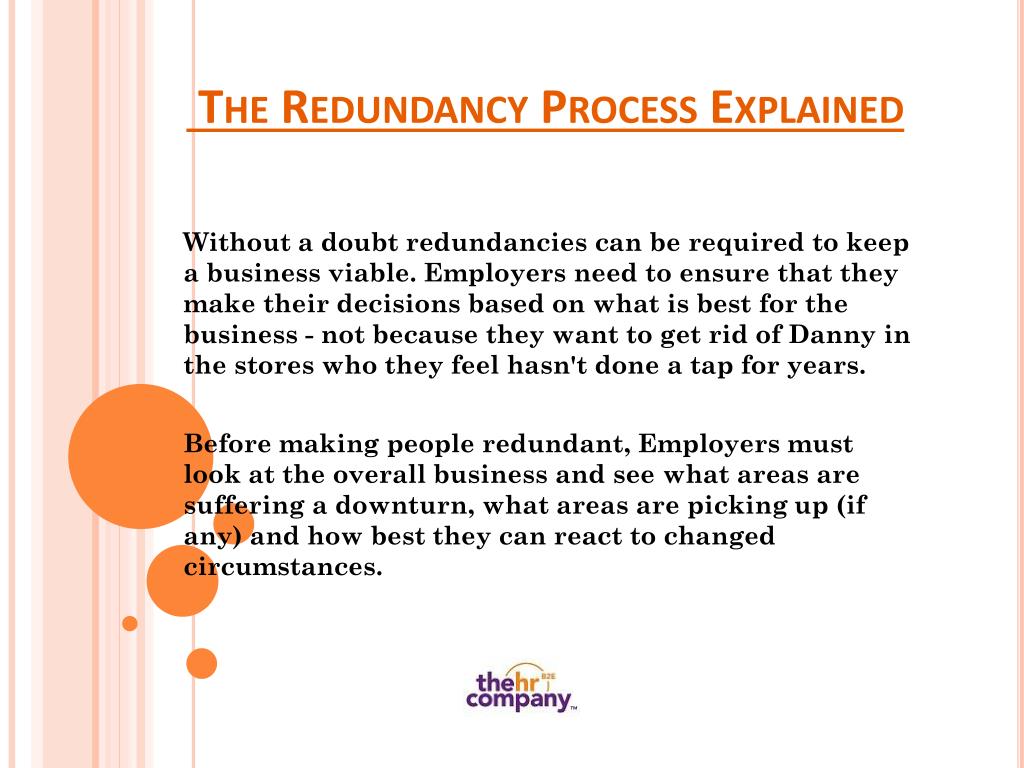Who Pays Redundancy Money? An In-depth Guide for Companies and Employees
Who Pays Redundancy Money? An In-depth Guide for Companies and Employees
Blog Article
Exploring the Interaction In Between Company Redundancy and Business Flexibility for Future Development
In the vibrant landscape these days's business globe, the intricate connection between firm redundancy and business flexibility becomes a critical aspect for sustained growth and success. Business often encounter the challenge of striking a fragile balance between preserving a degree of redundancy to reduce dangers and fostering versatility to react quickly to the ever-evolving market needs. This fragile interplay holds the key to not only enduring in rough times but also flourishing when faced with unpredictability. As we explore the complex dimensions of this interplay, appealing understandings into exactly how organizations browse these complexities to lead the way for future growth await.
Value of Firm Redundancy
Business redundancy is an important element that enhances business resilience and reduces operational threats. By integrating redundancy procedures within the business framework, companies can better endure unanticipated interruptions and changes in business setting. Redundancy serves as a critical buffer, enabling business to adapt and react efficiently to unanticipated obstacles without endangering essential procedures.
One trick facet of the importance of firm redundancy is its duty in making sure continuity during times of dilemma. When confronted with abrupt modifications or emergencies, redundant systems, resources, or employees can step in to preserve important functions and stop widespread disruptions. This connection not only safeguards the firm's track record and client trust but additionally reduces economic losses and functional downtime.

Techniques for Organizational Adaptability

One more vital technique is investing in innovation and framework that can support versatility and scalability. Executing electronic tools, automation, and information analytics can enhance operations, boost effectiveness, and give beneficial insights for educated decision-making. Furthermore, creating versatile business structures that enable fast changes to market dynamics and consumer demands is necessary for staying competitive in a swiftly progressing environment. By proactively recognizing prospective interruptions and possibilities, companies can proactively thrive and adapt in an ever-changing service landscape.
Harmonizing Redundancy and Adaptability
Attaining an unified balance between operational redundancy and organizational flexibility is paramount in navigating the intricacies of a dynamic business environment. Redundancy within a firm offers a security web, making certain connection and security in procedures. However, an extra of redundancy can lead to inadequacies and prevent versatility to changing market problems. On the various other hand, organizational adaptability allows firms to react without delay to exterior disturbances and confiscate brand-new possibilities. Striking the ideal equilibrium in between redundancy and adaptability is a delicate procedure that calls for a deep understanding of the organization's objectives, market characteristics, and danger resistance.
To achieve this equilibrium, business need to perform normal evaluations of their procedures to recognize locations where redundancy is needed for danger mitigation and where adaptability can drive technology and development. Executing flexible structures, cultivating a society of constant discovering and enhancement, and urging open communication across all levels of the organization are essential approaches to integrate redundancy and adaptability efficiently. By straightening these 2 important elements, firms can place themselves for lasting growth and success in an ever-changing company landscape.
Study on Adaptation Success
In taking a look at circumstances of effective business adaptation, it ends up being evident that the interaction between operational redundancy and flexibility is a specifying element in shaping resistant organizations. A DVD rental service, Netflix showed remarkable adaptability by transitioning into a streaming system when digitalization interfered with the market. These situation studies underscore the importance of operational redundancy coupled with business flexibility in cultivating long-term development and competition.
Structure Strength for Future Growth
Structure strength for future growth needs a calculated alignment of functional procedures with market dynamics and emerging fads. Companies must adjust to transforming settings by fostering a society of versatility, development, and continual improvement. Durability includes not just bouncing back from troubles but additionally proactively planning for future difficulties. One essential element of structure durability is investing in robust risk administration approaches to mitigate possible disturbances. This includes scenario planning, diversifying supply chains, and creating backup prepare for different backups (who pays redundancy money).
In addition, cultivating strong partnerships with stakeholders, such as clients, workers, vendors, and the neighborhood, is vital for keeping and weathering uncertainties count on and assistance during stormy times. Efficient Visit Your URL interaction and openness play a crucial duty in building strength, as they assist line up assumptions and facilitate cooperation in navigating uncertainties.
Moreover, companies require click to find out more to prioritize learning and growth efforts to upskill employees and outfit them with the necessary devices to adjust to changing circumstances. By spending in their workforce, companies can enhance their versatility and dexterity, eventually enhancing their strength for lasting future growth.
Verdict

In the vibrant landscape of today's organization globe, the complex connection between company redundancy and organizational adaptability arises as a vital variable for sustained growth and success. Business often face the challenge of striking a fragile balance between preserving a degree of redundancy to alleviate dangers and fostering flexibility to react quickly to the ever-evolving market demands.To attain this equilibrium, companies need to conduct regular assessments of their operations to recognize locations where redundancy is essential for danger mitigation and where versatility can drive advancement and growth.In conclusion, the interaction between business redundancy and organizational flexibility is crucial for future development. Structure resilience through a combination of redundancy and adaptability will ensure that firms are prepared for the my company obstacles of the future.
Report this page